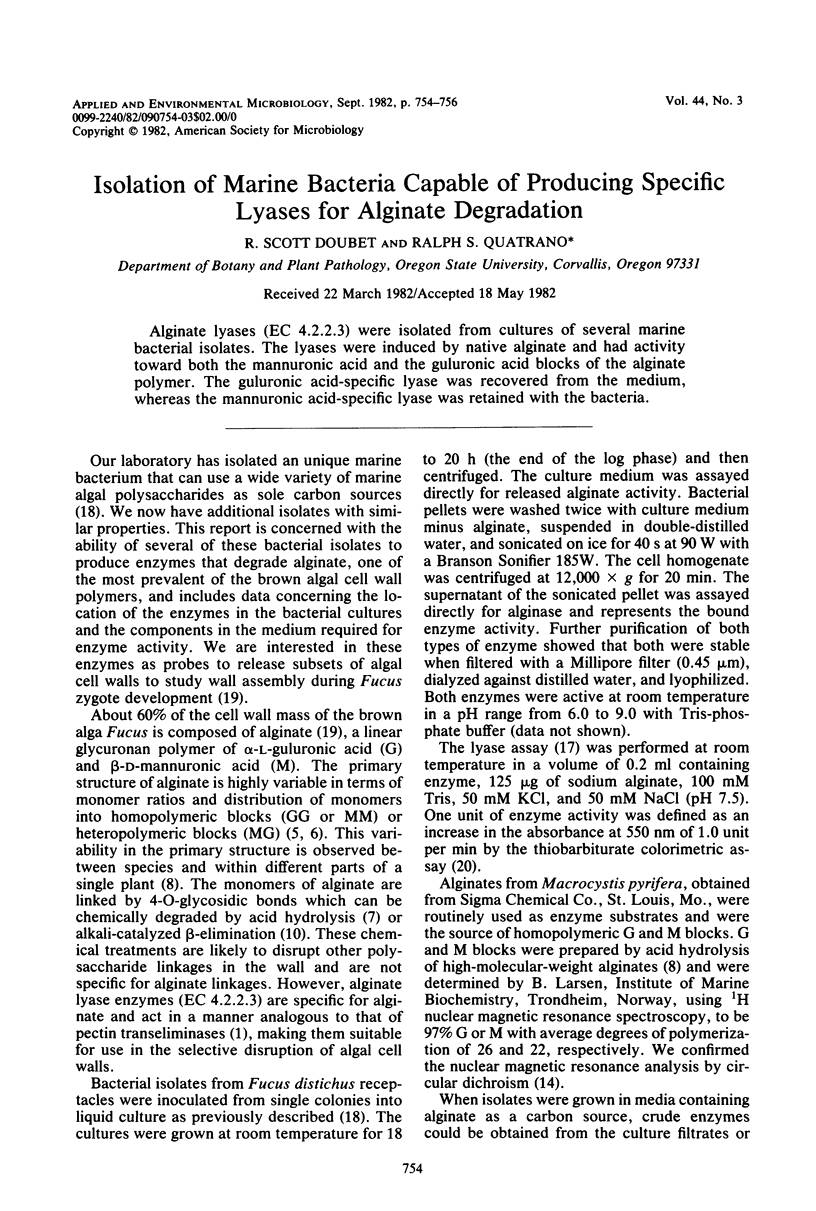Abstract
Alginate lyases (EC 4.2.2.3) were isolated from cultures of several marine bacterial isolates. The lyases were induced by native alginate and had activity toward both the mannuronic acid and the guluronic acid blocks of the alginate polymer. The guluronic acid-specific lyase was recovered from the medium, whereas the mannuronic acid-specific lyase was retained with the bacteria.
Full text
PDF


Selected References
These references are in PubMed. This may not be the complete list of references from this article.
- ALBERSHEIM P., NEUKOM H. DEUEL H: Splitting of pectin chain molecules in neutral solutions. Arch Biochem Biophys. 1960 Sep;90:46–51. doi: 10.1016/0003-9861(60)90609-3. [DOI] [PubMed] [Google Scholar]
- Boyd J., Turvey J. R. Isolation of poly-alpha-L-guluronate lyase from Klebsiella aerogenes. Carbohydr Res. 1977 Aug;57:163–171. doi: 10.1016/s0008-6215(00)81928-x. [DOI] [PubMed] [Google Scholar]
- Davidson I. W., Sutherland I. W., Lawson C. J. Purification and properties of an alginate lyase from a marine bacterium. Biochem J. 1976 Dec 1;159(3):707–713. doi: 10.1042/bj1590707. [DOI] [PMC free article] [PubMed] [Google Scholar]
- Kashiwabara Y., Suzuki H., Nisizawa K. Alginate lyases of pseudomonads. J Biochem. 1969 Oct;66(4):503–512. doi: 10.1093/oxfordjournals.jbchem.a129175. [DOI] [PubMed] [Google Scholar]
- Min K. H., Sasaki S. F., Kashiwabara Y., Suzuki H., Nisizawa K. Multiple components of endo-polyguluronide lyase of Pseudomonas sp. J Biochem. 1977 Mar;81(3):539–546. doi: 10.1093/oxfordjournals.jbchem.a131488. [DOI] [PubMed] [Google Scholar]
- Min K. H., Sasaki S., Kashiwabara Y., Nisizawa K. Substrate specificity of endo-polyguluronide lyases from Pseudomonas sp. on the basis of their kinetic properties. J Biochem. 1977 Mar;81(3):547–553. doi: 10.1093/oxfordjournals.jbchem.a131489. [DOI] [PubMed] [Google Scholar]
- Morris E. R., Rees D. A., Robinson G., Young G. A. Competitive inhibition of interchain interactions in polysaccharide systems. J Mol Biol. 1980 Apr;138(2):363–374. doi: 10.1016/0022-2836(80)90292-2. [DOI] [PubMed] [Google Scholar]
- Nakada H. I., Sweeny P. C. Alginic acid degradation by eliminases from abalone hepatopancreas. J Biol Chem. 1967 Mar 10;242(5):845–851. [PubMed] [Google Scholar]
- PREISS J., ASHWELL G. Alginic acid metabolism in bacteria. I. Enzymatic formation of unsaturated oligosac-charides and 4-deoxy-L-erythro-5-hexoseulose uronic acid. J Biol Chem. 1962 Feb;237:309–316. [PubMed] [Google Scholar]
- Quatrano R. S., Caldwell B. A. Isolation of a unique marine bacterium capable of growth on a wide variety of polysaccharides from macroalgae. Appl Environ Microbiol. 1978 Dec;36(6):979–981. doi: 10.1128/aem.36.6.979-981.1978. [DOI] [PMC free article] [PubMed] [Google Scholar]
- Quatrano R. S., Stevens P. T. Cell wall assembly in fucus zygotes: I. Characterization of the polysaccharide components. Plant Physiol. 1976 Aug;58(2):224–231. doi: 10.1104/pp.58.2.224. [DOI] [PMC free article] [PubMed] [Google Scholar]
- WEISSBACH A., HURWITZ J. The formation of 2-keto-3-deoxyheptonic acid in extracts of Escherichia coli B. I. Identification. J Biol Chem. 1959 Apr;234(4):705–709. [PubMed] [Google Scholar]


